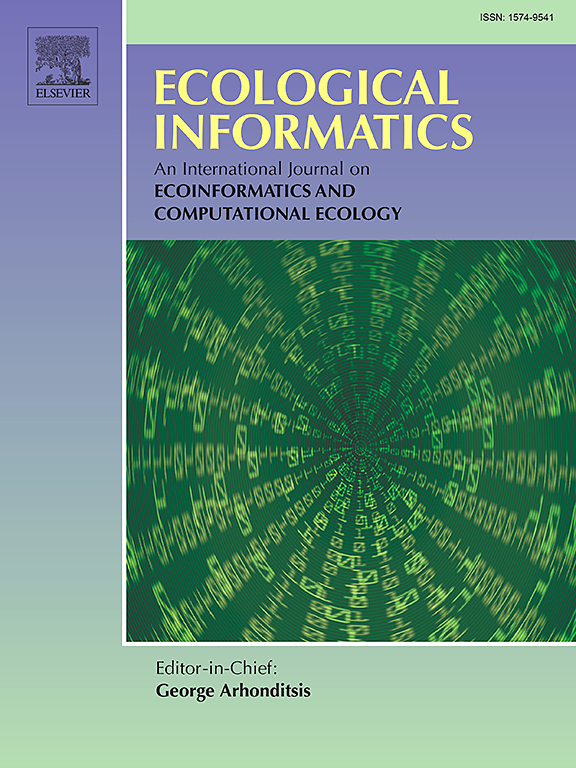扩散aae:利用条件扩散模型和对抗自编码器增强高光谱图像分类
IF 5.8
2区 环境科学与生态学
Q1 ECOLOGY
引用次数: 0
摘要
高光谱图像(HSI)分类对生态监测至关重要,但由于高维、复杂的光谱空间关系和有限的标记数据,面临着重大挑战。本研究介绍了DiffusionAAE,这是一种独特的框架,将对抗性自编码器(AAE)与条件扩散模型相结合,以解决这些挑战。与现有方法不同,DiffusionAAE将光谱相似性约束和类别标签引导纳入扩散过程,确保生成物理上真实的合成样本。我们的框架的关键创新在于其两阶段架构:首先,AAE提取强大的潜在特征,捕获复杂的光谱-空间关系;其次,条件扩散模型通过逐步去噪来细化这些特征,在保持高光谱数据固有物理约束的同时,能够生成特定类别的特征。在三个基准数据集上的综合实验证明了DiffusionAAE的优越性能:与目前最先进的方法相比,我们的方法在Indian Pines上的总体准确率(OA)达到96.77%(比基于cnn的方法高3.21%),在Pavia大学上的总体准确率(OA)达到99.56%(比基于变压器的方法提高1.24%),在Salinas上的总体准确率(OA)达到99.62%(比最佳竞争方法提高0.98%)。值得注意的是,DiffusionAAE在少数类别上表现出色,在Indian Pines数据集中代表性不足的类别上平均提高了7.35%的准确率。该框架在训练数据有限的情况下表现出特别的优势,即使只使用5%的可用标记样本,也能保持95.3%的准确率。这些结果表明,扩散aae在生态信息学应用方面取得了重大进展,特别是在生物多样性监测和土地覆盖分类方面,标记数据稀缺和分类不平衡是普遍存在的挑战。本文章由计算机程序翻译,如有差异,请以英文原文为准。
DiffusionAAE: Enhancing hyperspectral image classification with conditional diffusion model and Adversarial Autoencoder
Hyperspectral image (HSI) classification is essential for ecological monitoring, but faces significant challenges due to high dimensionality, complex spectral–spatial relationships, and limited labeled data. This study introduces DiffusionAAE, a novel framework that uniquely combines Adversarial Autoencoders (AAE) with conditional diffusion models to address these challenges. Unlike existing approaches, DiffusionAAE incorporates spectral similarity constraints and class label guidance into the diffusion process, ensuring the generation of physically realistic synthetic samples. Our framework’s key innovation lies in its two-stage architecture: first, an AAE extracts robust latent features capturing intricate spectral–spatial relationships; second, a conditional diffusion model refines these features through progressive denoising, enabling class-specific feature generation while maintaining physical constraints inherent to hyperspectral data. Comprehensive experiments on three benchmark datasets demonstrate DiffusionAAE’s superior performance: compared to state-of-the-art methods, our approach achieves significant improvements with an overall accuracy (OA) of 96.77% on Indian Pines (3.21% higher than CNN-based methods), 99.56% on University of Pavia (1.24% improvement over Transformer-based approaches), and 99.62% on Salinas (0.98% better than the best competing method). Notably, DiffusionAAE shows remarkable performance on minority classes, with an average 7.35% accuracy improvement across underrepresented classes in the Indian Pines dataset. The framework demonstrates particular strength in scenarios with limited training data, maintaining 95.3% accuracy even when using only 5% of available labeled samples. These results establish DiffusionAAE as a significant advancement for ecological informatics applications, especially for biodiversity monitoring and land cover classification where labeled data scarcity and class imbalance are prevalent challenges.
求助全文
通过发布文献求助,成功后即可免费获取论文全文。
去求助
来源期刊

Ecological Informatics
环境科学-生态学
CiteScore
8.30
自引率
11.80%
发文量
346
审稿时长
46 days
期刊介绍:
The journal Ecological Informatics is devoted to the publication of high quality, peer-reviewed articles on all aspects of computational ecology, data science and biogeography. The scope of the journal takes into account the data-intensive nature of ecology, the growing capacity of information technology to access, harness and leverage complex data as well as the critical need for informing sustainable management in view of global environmental and climate change.
The nature of the journal is interdisciplinary at the crossover between ecology and informatics. It focuses on novel concepts and techniques for image- and genome-based monitoring and interpretation, sensor- and multimedia-based data acquisition, internet-based data archiving and sharing, data assimilation, modelling and prediction of ecological data.
 求助内容:
求助内容: 应助结果提醒方式:
应助结果提醒方式:


